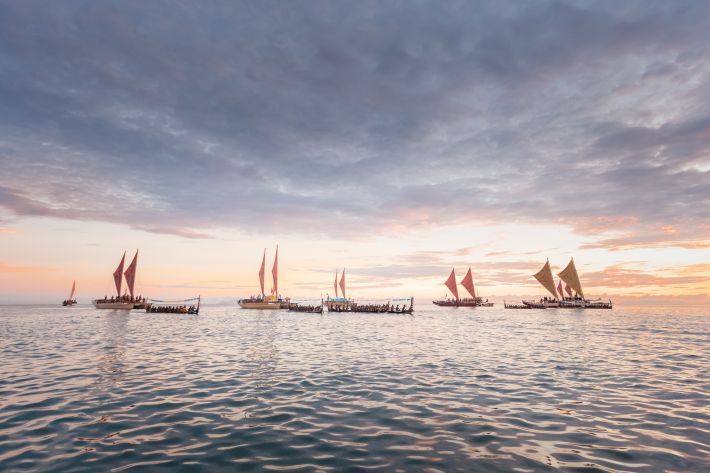As the 13th Festival of Pacific Arts & Culture convenes in Hawaiʻi, the event spotlights Indigenous excellence and the enduring leadership and unity among island peoples across the Pacific Ocean. In this vibrant gathering of delegates, scholars, practitioners, and artists, the shared history of the Pacific unfolds – a history marked by the visionary leadership of ancient chiefs and the modern efforts to revive traditional practices.
Kānaka Maoli are inextricably linked to the land, seas, and peoples across the Pacific not just in geography but by blood, language, and traditions. The migration of our ancestors to Hawaiʻi spans the Pacific seas leading back to our ancestral oceanic homeland, Moananuiākea.
Historically, Polynesian chiefs demonstrated exceptional leadership and strategic prowess; most prominently in the way they navigated the seas. When the Tahitian chief Moʻikeha came to Hawaiʻi to establish his dynasty, his hānai son Kamahualele declared with the resounding chant, “Eia Hawaiʻi,” stating “he kama na Kahiki,” or Hawaiʻi is a child of Tahiti. The aliʻi and his sons, Laʻamaikahiki and Kila, would travel back and forth between Tahiti and Hawaiʻi, engaging in continual interchange across the mighty Pacific. These exchanges were physical, cultural and spiritual, creating deep relationships between islands.
Other legendary trailblazers from Tahiti include Pele and Kamohoaliʻi, who arrived in Hawaiʻi with their ʻohana to become revered akua. These ancestral leaders turned the seas into highways, paths to share knowledge, culture and history across island groups. The Pacific Ocean even has a long-standing channel that connects Hawaiʻi to Tahiti, known as Kealakahiki. The corridor stretching between Kahoʻolawe and a cradle of islands in French Polynesia is where skilled wayfarers are able to navigate waʻa between island groups with relative ease.
A spiritual nexus originates in Marae Taputapuātea, one of the most sacred sites in Polynesia. Built on the island of Raʻiātea around 1000 A.D., the temple served as a place of worship and a meeting ground for powerful chiefs. Voyaging leaders carried revered pōhaku from this locus and planted them for satellite temples in Tahiti, Cook Islands, Hawaiʻi, and beyond. Kapukapuākea Heiau, once located in the Waialua moku of Oʻahu, faced Kaiaka Bay. Through these many paths, Hawaiʻi remains connected to their Pacific counterparts.
As nations developed, so did Hawaiʻi. The unification of the Hawaiian Islands by Kamehameha I was mirrored by Tāufaʻāhau in Tonga. In the nineteenth century, the Kamehameha and Pōmare dynasties expressed mutual support as Polynesian allies. Even the royal genealogy of Ke Aliʻi Bernice Pauahi Bishop is traced back to Tahiti. During his reign, King David Kalākaua laid the groundwork for a Polynesian Confederacy, sending his former minister of foreign affairs, John E. Bush, to Sāmoa, Tonga, and the like to express goodwill and explore potential alliances with Hawaiʻi.
In a time when European and American ethnographers and scientists were identifying groups of people under the formative definitions of race, Kalākauaʻs intentional focus on Polynesian peoples as kin illustrated his indigenous worldview, set apart from Western paradigms.
These necessary unions contributed to a Hawaiian renaissance that coalesced in the 1970s with the reemergence Polynesian voyaging. When the Polynesian Voyaging Society built a replica waʻa, they leaned on the traditions and knowledge of Micronesian leader Papa Mau Piailug. The return of a voyaging canoe, Hōkūleʻa, to islands in the eastern Pacific inspired the recovery of knowledge and practice of ceremonies and protocols of welcome and hosting – a renewed celebration of our shared heritage.
Hawaiʻi's connection to the Pacific and its Polynesian roots is a testament to the enduring bonds between island peoples. From the legendary leadership of Moʻikeha, Kamehameha and Kalākaua, the history of Polynesian leadership is rooted in innovation, exploration and unity. These leaders not only navigated the seas but also the changing cultural, spiritual and political landscapes, always sharing and advancing Pacific cultures.
As our Pacific relatives are welcomed to Hawaiʻi for the celebrations and collaborations of FestPAC, we honor the spirit of leadership that unites us across the Pacific, emphasizing Kamehameha Schools’ commitment to preparing ʻōiwi leaders to carry on this rich cultural legacy.

Photo courtesy of Festival of the Pacific Arts & Culture. Credit: Nicholas Tomasello
TAGS
moananuiākea,
pacific conversations,
native hawaiian identity,
ʻōiwi leadership
CATEGORIES
Kaipuolono Article, Regions, Kaua’i and Ni’ihau, Wai’anae Coast, ‘Ewa, Waialua, Kona, O’ahu, Ko’olau, Maui, Moloka’i and Lana’i, West Hawai’i, East Hawai’i, Themes, Culture, Community, Hawaii Newsroom, KS Hawaii Home, Kapalama Newsroom, Kapalama Home, KS Announcements, Maui Newsroom, KS Maui Home, Newsroom, Hawaii, Kapalama, Maui, Preschools, Community Education, Community Events, Oiwi Leaders
Print with photos
Print text only










